Blockade of tachykinin NK3 receptor reverses hypertension through a dopaminergic mechanism in the ventral tegmental area of spontaneously hypertensive rats
- PMID: 20804497
- PMCID: PMC3010589
- DOI: 10.1111/j.1476-5381.2010.01008.x
Blockade of tachykinin NK3 receptor reverses hypertension through a dopaminergic mechanism in the ventral tegmental area of spontaneously hypertensive rats
Abstract
Background and purpose: Intracerebroventricularly injected tachykinin NK(3) receptor (R) antagonists normalize mean arterial blood pressure (MAP) in spontaneously hypertensive rats (SHR). This study was pursued to define the role played by NK(3)R located on dopamine neurones of the ventral tegmental area (VTA) in the regulation of MAP in SHR.
Experimental approach: SHR (16 weeks) were implanted permanently with i.c.v. and/or VTA guide cannulae. Experiments were conducted 24 h after catheterization of the abdominal aorta to measure MAP and heart rate (HR) in freely behaving rats. Cardiovascular responses to i.c.v. or VTA-injected NK(3)R agonist (senktide) and antagonists (SB222200 and R-820) were measured before and after systemic administration of selective antagonists for D(1)R (SCH23390), D(2)R (raclopride) or non-selective D(2)R (haloperidol), and after destruction of the VTA with ibotenic acid.
Key results: I.c.v. or VTA-injected SB222200 and R-820 (500 pmol) evoked anti-hypertension, which was blocked by raclopride. Senktide (10, 25, 65 and 100 pmol) elicited greater increases of MAP and HR when injected in the VTA, and the cardiovascular response was blocked by R-820, SCH23390 and haloperidol. VTA-injected SB222200 prevented the pressor response to i.c.v. senktide, and vice versa, i.c.v. senktide prevented the anti-hypertension to VTA SB222200. Destruction of the VTA prevented the pressor response to i.c.v. senktide and the anti-hypertension to i.c.v. R-820.
Conclusions and implications: The NK(3)R in the VTA is implicated in the maintenance of hypertension by increasing midbrain dopaminergic transmission in SHR. Hence, this receptor may represent a therapeutic target in the treatment of hypertension.
© 2010 The Authors. British Journal of Pharmacology © 2010 The British Pharmacological Society.
Figures
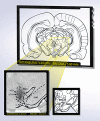


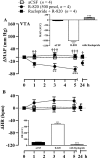
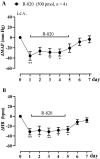
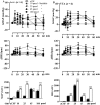
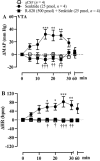
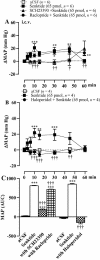
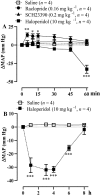
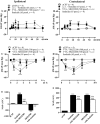
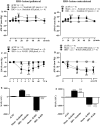
Similar articles
-
The ventral tegmental area as a putative target for tachykinins in cardiovascular regulation.Br J Pharmacol. 2005 Jul;145(6):712-27. doi: 10.1038/sj.bjp.0706249. Br J Pharmacol. 2005. PMID: 15895109 Free PMC article.
-
Implication of nigral tachykinin NK3 receptors in the maintenance of hypertension in spontaneously hypertensive rats: a pharmacologic and autoradiographic study.Br J Pharmacol. 2003 Feb;138(4):554-63. doi: 10.1038/sj.bjp.0705042. Br J Pharmacol. 2003. PMID: 12598409 Free PMC article.
-
The neurokinin-3 receptor (NK3R) antagonist SB222200 prevents the apomorphine-evoked surface but not nuclear NK3R redistribution in dopaminergic neurons of the rat ventral tegmental area.Neuroscience. 2013 Sep 5;247:12-24. doi: 10.1016/j.neuroscience.2013.05.006. Epub 2013 May 11. Neuroscience. 2013. PMID: 23673279
-
Role of the mesolimbic dopamine system in cardiovascular homeostasis. Stimulation of the ventral tegmental area modulates the effect of vasopressin on blood pressure in conscious rats.Clin Exp Pharmacol Physiol. 1998 Sep;25(9):661-8. doi: 10.1111/j.1440-1681.1998.tb02273.x. Clin Exp Pharmacol Physiol. 1998. PMID: 9750953 Review.
-
Ventral tegmental area 5-HT receptors: mesolimbic dopamine release and behavioural studies.Behav Brain Res. 1996;73(1-2):1-5. doi: 10.1016/0166-4328(96)00061-7. Behav Brain Res. 1996. PMID: 8788468 Review.
Cited by
-
Neurokinin 3 receptor antagonism rapidly improves vasomotor symptoms with sustained duration of action.Menopause. 2018 Aug;25(8):862-869. doi: 10.1097/GME.0000000000001090. Menopause. 2018. PMID: 29533369 Free PMC article.
-
Neurokinin 3 Receptor Antagonists Compared With Serotonin Norepinephrine Reuptake Inhibitors for Non-Hormonal Treatment of Menopausal Hot Flushes: A Systematic Qualitative Review.Adv Ther. 2021 Oct;38(10):5025-5045. doi: 10.1007/s12325-021-01900-w. Epub 2021 Sep 12. Adv Ther. 2021. PMID: 34514552 Free PMC article.
References
-
- Amenta F, Ricci A, Rossodivita I, Avola R, Tayebati SK. The dopaminergic system in hypertension. Clin Exp Hypertens. 2001;23:15–24. - PubMed
-
- Angrist B, Sanfilipo M, Wolkin A. Cardiovascular effects of 0.5 milligrams per kilogram oral d-amphetamine and possible attenuation by haloperidol. Clin Neuropharmacol. 2001;24:139–144. - PubMed
-
- Cador M, Rivet JM, Kelley AE, Le Moal M, Stinus L. Substance P, neurotensin and enkephalin injections into the ventral tegmental area: comparative study on dopamine turnover in several forebrain structures. Brain Res. 1989;486:357–363. - PubMed
-
- Carson R. Histotechnology: A Self-Instructional Text. 1st edn. Chicago: ASCP Press; 1992.
Publication types
MeSH terms
Substances
Grants and funding
LinkOut - more resources
Full Text Sources
Other Literature Sources
Medical

